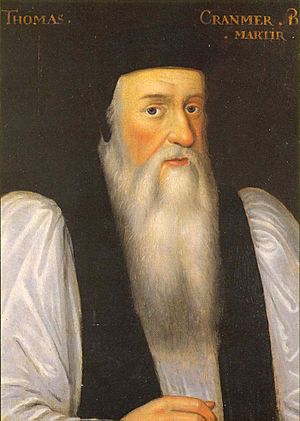History of the Puritans under Elizabeth I facts for kids
The reign of Elizabeth I of England, from 1558 to 1603, saw the start of the Puritan movement in England. Puritans were a group of Protestants who wanted to make the Church of England even more "pure." They believed the church still had too many practices from the Roman Catholic Church. Their ideas often clashed with the Queen and church leaders.
These disagreements sometimes led to the Puritans being stopped as a political group in the 1590s. But their ideas continued to spread. This led to bigger problems between Anglicans and Puritans in the 17th century, during the reigns of King James (1603–1625) and King Charles I (1625–1649). These tensions eventually helped cause the English Civil War (1642–1651). After the war, Oliver Cromwell, a Puritan leader, ruled England for a short time (1653–1658) during the English Commonwealth (1649–1660). The Puritan movement helped shape the ideas of political and religious freedom that are important in many English-speaking countries today.
Puritans wanted to reform the Church of England further. They aimed to remove all Catholic influences and promote a strong Protestant faith. They believed this faith should follow the Bible very closely and match the ideas of Reformed theology. This Puritan vision later led to important religious documents like the Westminster Confession of Faith.
Contents
How the English Church Changed (Before 1559)
The English Reformation began in the 1530s. This was when Henry VIII separated the Church of England from the pope and the Roman Catholic Church. During Henry's rule, Protestants were a small group in England. Henry often changed his mind, sometimes favoring Protestants and sometimes those who wanted to keep Catholic ways.
Even Protestants had different ideas. By the 1540s, Lutherans and Swiss Reformed churches disagreed on many things. For example, they argued about predestination, which is the idea that God has already decided who will be saved. They also disagreed on using religious images. Reformed Christians thought statues, stained glass, and pictures in churches were wrong. They also disliked traditional church clothes, called vestments. They preferred their ministers to wear simple black gowns. Reformed services were simple, focusing on prayer and preaching. Lutherans, however, believed that Christ was truly present in the Lord's Supper. They also didn't mind religious images or vestments. Many English Protestants felt the Reformed churches were more faithful to the Bible.
When Henry's son, Edward VI, became king, the English Church became more Reformed (or Calvinist). By 1548, important English Protestants, like Thomas Cranmer, the Archbishop of Canterbury, accepted Reformed ideas about the Lord's Supper. Protestant beliefs were put into a new church service book called the 1549 Book of Common Prayer. A revised version in 1552 made these ideas even clearer. Religious parades were stopped, and priests were allowed to marry. Prayers for the dead and special masses were ended. Statues, stained glass, and wall paintings in churches were destroyed.
In 1553, Edward VI died. His Catholic half-sister, Mary I of England, became queen. Mary wanted to end the English Reformation and bring the Church of England back to the Roman Catholic Church. About a thousand English Protestants, known as the Marian exiles, left England for religious reasons. German Lutheran areas did not welcome them. So, these exiles started English Protestant churches in towns in the Rhineland (like Wesel and Frankfurt) and Swiss cities (like Zurich and Geneva). During their exile, English Protestants learned about the very strict Calvinist churches, especially in Geneva. Many wanted to bring these ideas back to England after Mary died.
Elizabeth's Religious Plan (1559)
In 1558, Queen Mary died, and her half-sister, Elizabeth, became Queen of England. Elizabeth had been raised as a Protestant. In her first year, many of the Marian exiles returned to England. In 1559, Elizabeth created a religious compromise known as the Elizabethan Religious Settlement. This plan tried to make England Protestant while not completely upsetting people who had supported Catholicism. The settlement was made stronger in 1563.
The Church of England under Elizabeth was generally Reformed. Elizabeth's first Archbishop of Canterbury, Matthew Parker, supported Reformed ideas. His replacement, Edmund Grindal, also had strong Reformed ties. While Elizabeth's plan was mostly accepted, some groups were not happy. The call for "further reform" in the 1560s was the beginning of the Puritan Movement.
Puritans were not satisfied with the Anglican settlement. They believed the English church and state needed more reform based on the Bible. They wanted the church to be like the Reformed churches in Europe. They disliked the rule of bishops and the required use of the Book of Common Prayer. They also opposed many Anglican rituals. They felt these things stopped people from having true faith. They believed most people were stuck in old forms and rituals, leading to false religion.
Puritans wanted to get rid of all sins, rituals, and superstitions that "smacked of Roman Catholic idolatry." This included the Catholic Mass, the surplice (a white robe for clergy), kneeling at the Lord's Supper, other vestments, and religious images. They also disliked immoral plays and the widespread disrespect of the Sabbath.
Puritans wanted a deep change in beliefs that was Calvinistic. They also wanted a full reform of the English church and society based on the Bible, not human traditions.
The Puritan movement in Elizabethan England grew stronger because many of Queen Elizabeth's top advisers were close to Puritan leaders. These advisers themselves favored Puritan ideas about religion and politics. They especially wanted to limit the power of Anglican bishops and remove any Catholic influence. Important advisers included William Cecil, Francis Walsingham, Walter Mildmay, and Robert Dudley, Earl of Leicester. It seems Elizabeth, though Anglican, relied on Puritan leaders for support and advice.
The famous poet of Elizabeth's time, Edmund Spenser, also promoted Puritan views. His epic poem, The Faerie Queene, celebrates Elizabeth I. The main hero, the Red Cross Knight, is meant to show Puritan goodness. Una, his future wife, represents the church made pure from sin.
The balance and conflict between Anglicanism and Puritanism could be seen in John Jewel, a key person in the Anglican settlement. Jewel was both Anglican and Puritan in many ways. His Apology for the Church of England is very Anglican. Yet, his "Essay on Holy Scripture" is quite Puritan.
Four influential reformers helped the rise of English Puritanism during Elizabeth's reign (1558–1603). These were John Calvin, Henry Bullinger, Peter Martyr, and Theodore Beza. They often communicated with the Queen and English Reformed leaders. Calvin and Bullinger praised Queen Elizabeth for her reforms. They encouraged Puritans to be patient. Beza, however, supported the Puritan movement more strongly. In the 1560s and 1570s, Calvin's writings were the most popular in England. Works by Beza, Bullinger, and Vermigli were also widely read.
The Puritan movement in England was also helped by John Knox and the Scottish Reformation. Knox spent five years in England (1549–1554) helping the English Reformation. He then lived with Calvin in Geneva for several years (1554–1559). After that, he returned to Scotland to lead its reformation until his death in 1572. Knox's influence on English Puritanism was significant. Some historians even call him the first Puritan.
Archbishop Matthew Parker (1559–1575)
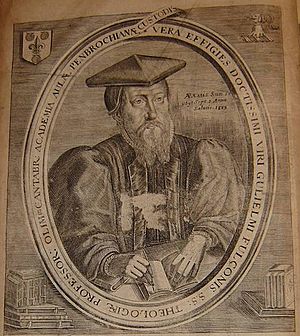
Church Meeting of 1562/3
The Convocation of 1563 began on January 15, 1562/3. This church meeting approved the Thirty-Nine Articles as a statement of beliefs for the Church of England. The bishops suggested more reforms to church law and services. These included getting rid of vestments, kneeling at communion, and the sign of the cross in baptism. They also wanted to change church music. Some clergy started these reforms in their own churches. For example, at Cambridge, William Fulke convinced his students not to wear their surplices (a type of vestment). He even told them to hiss at students who did. Because of this, Archbishop Parker published rules called Advertisements, requiring everyone to wear the same clerical clothes.
Arguments Over Church Clothes (1563–1569)
The Puritans strongly objected to the required church clothes. They asked reformers in Europe to support them. But many European reformers felt the Puritans were just causing trouble. For example, Heinrich Bullinger wrote to Bishop Grindal, saying Puritans were being "contentious" while claiming it was about their conscience. Grindal published this letter without Bullinger's permission. Theodore Beza supported the Puritans more. However, he didn't speak too loudly because he didn't want to anger the Queen. He hoped she would help the Huguenots (French Protestants). Because some clergy refused to wear their vestments, 37 ministers were suspended. In response, in 1569, some ministers started holding their own services. This was an early example of Puritans separating from the Church of England.
The Admonition to the Parliament (1572) and Calls for Presbyterianism
In the 1560s, England's return to Protestantism was still uncertain. Many people wanted to go back to Catholicism. Around 1570, three events helped strengthen Protestantism in England. First, in the Rising of the North, northern nobles rebelled, demanding a return to Catholicism. Second, after the Catholic Mary, Queen of Scots, was executed, Pope Pius V issued a special order called Regnans in Excelsis. This order told Catholics they no longer had to be loyal to Elizabeth. Third, the Ridolfi plot tried to replace Elizabeth with Mary, Queen of Scots.
Because of these Catholic rebellions, the English government took steps to strengthen Protestantism. First, all clergy had to agree to the Thirty-Nine Articles. Second, all regular church members had to take communion in their home church at least once a year. Third, it became a serious crime to say the Queen was a heretic.
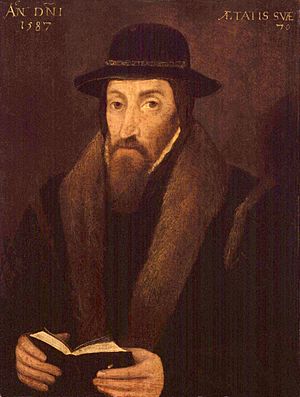
In this strong Protestant, anti-Catholic time, Puritans tried to push for more reforms in the Church of England. John Foxe and Thomas Norton presented a reform plan to Parliament. Elizabeth quickly rejected it, insisting on the 1559 religious settlement. Meanwhile, at Cambridge, Professor Thomas Cartwright spoke against vestments. In 1570, he gave lectures calling for the end of bishops and the creation of a presbyterian church system in England.
Puritans were even more upset when bishops combined the vestment issue with the requirement to agree to the Thirty-Nine Articles. When clergy swore loyalty to the Thirty-Nine Articles, bishops also made them swear that using the Book of Common Prayer and wearing vestments was not against the Bible. Many Puritan clergy were very angry about this. A bill to allow changes to the Prayer Book for clergy who felt it went against their conscience was defeated in Parliament.
At Cambridge, Vice-Chancellor John Whitgift acted against Thomas Cartwright. He removed Cartwright from his professorship in 1571.
Because of these events, in 1572, two London clergymen, Thomas Wilcox and John Field, wrote the first important Puritan document. It was called Admonition to the Parliament. According to this Admonition, Puritans had accepted the Book of Common Prayer, even with its faults, to keep peace in the church.
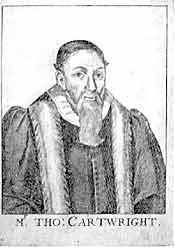
However, now that bishops required them to agree to the Prayer Book, Puritans felt they had to point out the "popery and superstition" it contained. The Admonition called for deeper church reforms, like those made by the Huguenots or the Church of Scotland under John Knox. The Admonition ended by criticizing bishops and calling for a presbyterian system instead of bishops.
The Admonition to Parliament caused a big debate in England. John Whitgift wrote an Answer against the Admonition. This led to Thomas Cartwright's Replye (1573), another important Puritan text. Cartwright argued that a truly reformed church must have four types of ministers, as identified by Calvin: teaching elders, ruling elders, deacons, and theology professors. Cartwright strongly argued against any minister being above another. In a Second Replye, Cartwright was even more forceful. He said that any minister having higher rank went against divine law. He also said that a presbyterian system of presbyteries and synods was required by divine law.
In 1574, Walter Travers, an ally of Cartwright, published a Full and Plaine Declaration of Ecclesiasticall Discipline. This book explained a reform plan in more detail.
The government took action against these three Puritan leaders. John Field and Thomas Wilcox were jailed for a year. Thomas Cartwright fled to Europe to avoid being arrested. In the end, however, too many clergy refused to agree to the bishops' demands. So, some clergy were allowed to agree with some conditions.
Archbishop Edmund Grindal (1575–1583)
The time Edmund Grindal was Archbishop of Canterbury (1575–1583) was quite calm compared to his predecessor. The main issue came in 1581. Robert Browne and his church in Bury St Edmunds left the Church of England. They said the Church of England had ministers who didn't preach much and lacked proper church rules. Browne and his followers, called the Brownists, had to go into exile in the Netherlands. There, Thomas Cartwright encouraged them. Cartwright was then a minister for the Merchant Adventurers in Middelburg. However, Cartwright was against separatism. Like most Puritans, he wanted to reform the Church of England from within.
Another Puritan development under Grindal was the rise of prophesying. This was based on a practice in Zurich. Ministers met weekly to discuss "profitable questions." These questions included how to properly use the Sabbath. This was an early sign of English Puritans focusing on keeping Sunday holy. The Queen did not like these meetings and told Archbishop Grindal to stop them. Grindal refused, saying it was allowed by the Bible. Because of this, he was disgraced and kept under house arrest for the rest of his time as Archbishop. The meetings started again after a short break.
Archbishop John Whitgift (1583–1604)
John Whitgift had been a strong opponent of Thomas Cartwright. He believed that church governance was an adiaphora, meaning "a matter that doesn't really matter." He thought the church should fit the government of the country it was in. Since England was a monarchy, the church should have a system with bishops.
New Calls for Presbyterianism
From 1583 to 1585, James Stewart briefly held power in Scotland. During this time, Scotland passed the Black Acts, which outlawed the Second Book of Discipline. Because of this, many Scottish ministers, including Andrew Melville, sought safety in England. These refugees joined the English Puritan meetings. They convinced many English Puritans to renew their fight to establish presbyterianism in England. So, in the 1584 Parliament, Puritans tried to pass laws to replace the Book of Common Prayer with the Genevan Book of Order and to bring in presbyterianism. This effort failed.
At this point, John Field, Walter Travers, and Thomas Cartwright were all free and back in England. They decided to write a new plan for the Church of England. They drafted a Book of Discipline, which was shared in 1586. They hoped Parliament would accept it that year. Again, the Puritan effort in Parliament failed.
Martin Marprelate (1588–1589) and the Response
In 1588–1589, a series of very strong anti-bishop writings were published. They used the pseudonym of Martin Marprelate. These Marprelate tracts, likely published by Job Throckmorton and John Penry, called bishops "agents of Antichrist." This was the strongest possible insult for Christians. The tracts called bishops "our vile servile dunghill ministers of damnation, that viperous generation, those scorpions."
Unfortunately for the Puritans, many of their supporters in the English government died in the late 1580s. These included Francis Russell, 2nd Earl of Bedford in 1585, Robert Dudley, 1st Earl of Leicester in 1588, and Francis Walsingham in 1590. In these circumstances, Richard Bancroft (John Whitgift's assistant) led a crackdown against the Puritans. Cartwright and eight other Puritan leaders were jailed for eighteen months. They then faced trial in the Star Chamber. The Puritan meetings were stopped.
Some Puritans followed Robert Browne's example and left the Church of England. Several of these separatists were arrested in the woods near Islington in 1593. John Greenwood and Henry Barrowe were executed for supporting separatism. Followers of Greenwood and Barrowe fled to the Netherlands. They would later form the basis of the Pilgrims, who founded the Plymouth Colony in North America.
In 1593, the English Parliament also passed the Religion Act and the Popish Recusants Act. These laws said that anyone worshipping outside the Church of England had three months to either join the Church of England or leave the country. If they left, they would lose their land and goods. If they failed to leave, it was a crime punishable by death. Although these laws were aimed at Roman Catholics, they also applied to many Puritans. No Puritans were executed under these laws, but they were a constant threat.
The Push for Preaching Ministers

One very important part of the Puritan movement was their demand for ministers who could preach throughout the country. When Elizabeth's religious plan was made, less than 10% of England's 40,000 parish clergy were allowed to preach. Since the 14th century, it had been illegal for a priest to preach without a special permit from his bishop. Elizabeth herself was not a big fan of preaching. She preferred church services that focused on the Prayer Book. However, many of Elizabeth's bishops did support training more preachers. With help from wealthy people, they greatly increased the number of qualified preachers. For example, Sir Walter Mildmay founded Emmanuel College, Cambridge in 1584 to train preaching ministers. The great Puritan preacher Laurence Chaderton was the head of this college. He was friends with Thomas Cartwright, Richard Rogers, Richard Greenham, John Dod, and William Perkins. All of them greatly influenced English Puritanism. Frances Sidney, Countess of Sussex also founded Sidney Sussex College, Cambridge in 1596. Emmanuel and Sidney Sussex became centers of Puritan learning.
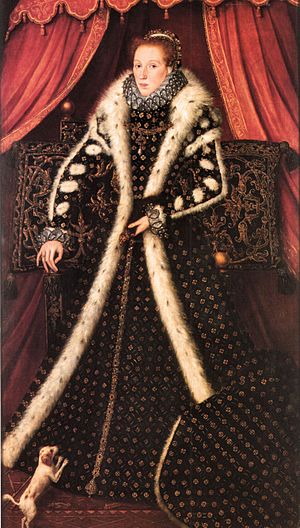
Even though the number of preachers grew a lot during Elizabeth's reign, there were still not enough. A person who wanted to hear a sermon might have to travel to another church to find a preaching minister. When they got there, the minister might have shortened the Prayer Book service to allow more time for preaching. A trained minister was also more likely to offer a spontaneous prayer instead of just reading from the Prayer Book. So, two different styles developed in the Church of England. One was the traditional style, focusing on the Book of Common Prayer. The other was the Puritan style, focusing on preaching, with less ceremony and shorter, spontaneous prayers.
One of the greatest Elizabethan Puritan preachers was Henry Smith. His powerful speaking earned him the nickname "Silver-tongued Smith."
The Rise of "Experimental Predestinarianism"
After the crackdown on Puritanism following the Marprelate Tracts, Puritans in England became more quiet in the 1590s. Ministers who wanted more reforms started to focus less on changing the Church of England's structure. Instead, they focused on individual, personal holiness. Theologians like William Perkins of Cambridge kept the high standards of earlier Puritans. But they now focused on making individuals more righteous, rather than the whole church. A common Puritan focus during this time was on stricter keeping of the Christian Sabbath. William Perkins is also known for bringing Theodore Beza's idea of double predestination to English Puritans. He made this idea popular using a chart called "The Golden Chain."
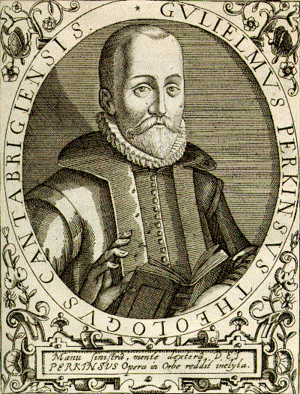
In 1970, R. T. Kendall called the religion practiced by William Perkins and his followers experimental predestinarianism. Kendall contrasted this with credal predestinarianism. Credal predestinarians were those who accepted the Calvinist teaching on predestination. Experimental predestinarians, however, went further. They taught that people could know for sure that they were saved and chosen by God for eternal life. (Credal predestinarians believed only some were chosen, but that it was impossible to know who was chosen in this life.) Puritans who followed Perkins' experimental predestinarianism felt they had to find others who had similar religious experiences.
Over time, some Puritan clergy and church members, who called themselves "the godly," began to see themselves as different from other members of the Church of England. These others had not had a strong emotional conversion experience. Sometimes, this led to calls for "the godly" to separate from the Church of England. While most Puritans remained "non-separating Puritans," they still became a distinct social group within the Church of England by the early 17th century. In the next reign (King James), "the Puritan" was common enough that the playwright Ben Jonson could make fun of them in his plays. So, by the end of Elizabeth's reign, Anglicans and Puritans were often in deep conflict. Many Puritans would make fun of the Anglican church, saying its rituals and bishops harmed true religion. At the same time, the Puritan movement had ministers and leaders who believed in different church structures: congregational, presbyterian, or episcopal.
The peak of the Elizabethan Puritan movement can be seen in three great men and their works: 1. The theological writings of William Perkins. 2. The sermons of Henry Smith. And 3. The poetry of Edmund Spenser.
Important Puritan Leaders
- John Foxe (1516–1587) was a historian and author of Acts and Monuments, also known as "Foxe's Book of Martyrs." This book told the stories of Christian martyrs, especially English Protestants who suffered under Mary I.
- Thomas Norton (1532–1584) was a lawyer, politician, and writer against Catholicism. He also translated John Calvin's Institutes of the Christian Religion into English.
- Myles Coverdale (1488–1569) was an English reformer, Bible translator, and once Bishop of Exeter. He was known for his preaching and Bible knowledge.
- William Whittingham (1524–1579) was a preacher, Bible scholar, and translator of the Geneva Bible. He was friends with John Knox, John Calvin, and Henry Bullinger. When he returned to England, he promoted Presbyterianism and preaching meetings.
- Laurence Humphrey (1527–1590) was a scholar and theologian. He was President of Magdalen College, Oxford, and made it a Puritan stronghold. He played a key role in the arguments over church clothes.
- David Whitehead (1492?–1571) was a scholar and theologian who refused to be Archbishop of Canterbury because of his Puritan beliefs.
- Thomas Sampson (1517–1589) was a preacher, Bible scholar, and Marian exile. He was one of the Geneva Bible translators. With Laurence Humphrey, he was important in the vestments controversy.
- Anthony Gilby (1510–1585) was a preacher, scholar, and translator of the Geneva Bible. He was known for his Bible commentaries. He also wrote a popular "Treatise on the Doctrine of Election."
- Christopher Goodman (1520–1603) was a preacher and Marian exile. He spent years with John Knox as a friend, working on the Scottish Reformation. Goodman later returned to England. He was best known for his book on political theology, "How Superior Powers Ought to be Obeyed."
- Richard Greenham (1535–1594) was a preacher, scholar, and theologian. He was a close friend of William Perkins and known for his devotional writings, including his "Treatise on the Sabbath."
- Thomas Cartwright (1535–1603) was a preacher, scholar, and debater. He is seen as the father of the Presbyterian movement within Puritanism. He was known for his arguments and letters.
- Laurence Chaderton (1536–1640) was the first Master of Emmanuel College, Cambridge. He was one of the translators of the King James Version of the Bible. Chaderton lived over 100 years and was known as a great leader of the Puritan movement.
- Edward Dering (1540–1576) was a fiery preacher, classical scholar, and debater. He supported Thomas Cartwright. Dering was often in trouble from 1570 for strongly opposing bishops.
- William Fulke (1538–1589) was a preacher, scholar, and debater who played a leading part in the Vestments controversy.
- Thomas Wilcox (1549–1608) was a preacher, scholar, and debater best known for his call for reformation titled "An Admonition to Parliament."
- Walter Travers (1545–1638) was a scholar and theologian best known for opposing the Anglican church views of Richard Hooker.
- Arthur Dent (1545–1607) was a preacher and theologian known for his sermons and devotional works, especially "The Plain Man's Pathway to Heaven."
- John Knewstub (1544–1624) was a preacher and scholar who took part in the Hampton Court Conference of 1604, representing the Puritan side. He believed in Presbyterianism but was moderate in his Puritan views.
- John Field (1545–1588) was a scholar and debater who helped Thomas Wilcox write and publish "An Admonition to Parliament."
- Job Throckmorton (1545–1601) was a Puritan activist, writer, and Member of Parliament. Most believe he wrote the Martin Mar-prelate tracts (satires against clergy), along with John Penry and John Udall.
- Andrew Melville (1545–1622) was a Scottish scholar, theologian, and religious reformer after John Knox. His fame encouraged scholars from Europe to study in Scotland.
- John Dod (1549–1645) was a nonconformist preacher and Bible teacher. He was known for his Exposition of the Ten Commandments, which earned him the nickname Decalogue Dod.
- Robert Browne (1550–1633) was a preacher and founder of the Brownists, early Separatists from the Church of England. Later in life, he rejoined the established church and became an Anglican minister. He was known for his early works, "A True and Short Declaration" and "A Treatise of Reformation without Tarrying."
- Henry Barrowe (1550–1593) was a Separatist Puritan who supported independent churches. He was executed, along with John Greenwood, for his political views, which were seen as rebellious.
- John Greenwood (1556–1593) was a Separatist Puritan who also supported independent churches. He was executed along with Henry Barrowe for his radical political views, which were seen as rebellious.
- Eusebius Pagit (1551–1617) was a preacher and nonconformist known for his many sermons and strong support of Thomas Cartwright.
- John Udall (1550–1592) was a preacher and debater linked to the Martin Mar-prelate tracts. Anglican authorities prosecuted him for his many controversial writings.
- Richard Rogers (1550–1618) was a fellow of Emmanuel College, Cambridge. He was known for his strong Bible preaching. His "Seven Treatises" on the Christian Life were very important to the Puritan movement.
- Henry Smith (1560–1591) was a preacher who lived only 31 years and preached for only 5–7 years. He was known as the most eloquent preacher of the Elizabethan age.
- William Perkins (1558–1602) was Master of Emmanuel College, Cambridge. He was the most active Puritan theologian and Bible teacher during the Elizabethan era. Perkins is best known for his "Golden Chain of Theology" and his commentary on Paul's letter to the Galatians.


